Archaeological Ensemble of Mérida: The city of Mérida was founded as Augusta Emerita in 25 BC. Augusta Emerita was the Roman name for Mérida. Augusta Emerita was the capital city of Roman Lusitania. Augusta Emerita was the centre of a great number of roads branching out into the Hispanic territory. Roads such as the Silver Route, the roads to Lisbon, Córdoba and Toledo all met in Merida. The Archaeological Ensemble of Mérida has many monuments from Roman times, such as a theatre, an amphitheatre, temples, aqueducts and a stone bridge over the Guadiana River. The Roman theatre of Mérida was built in 15 and 16 BC. The Roman theatre of Mérida is the most complete and the best preserved in Europe. The Roman amphitheatre of Mérida was officially opened in 8 BC. The amphitheatre is located close to the Roman theatre of Mérida. The Los Milagros Aqueduct was built during the 1st century AD, the aqueduct was one of three built at Mérida, the other aqueducts of Augusta Emerita were the San Lázaro Aqueduct and the Aqua Augusta. Archaeological Ensemble of Mérida is located in west-central Spain. The Archaeological Ensemble of Mérida is one of the largest archaeological sites in Spain. Mérida is situated about 75 km south of the World Heritage Old Town of Cáceres. The Archaeological Ensemble of Mérida was declared a UNESCO World Heritage in 1993.
www.werelderfgoedfotos.nl © Copyright World Heritage Photos

Archaeological Ensemble of Mérida: The Los Milagros Aqueduct was built in the first century AD. The Los Milagros Aqueduct was one of three aqueducts built at Augusta Emerita, present-day Mérida, the other two aqueducts were the San Lázaro Aqueduct and the Aqua Augusta. The Los Milagros Aqueduct has a maximum height of 25 metres. The arches were constructed of granite combined with brick. The Los Milagros Aqueduct crosses the River Albarregas.
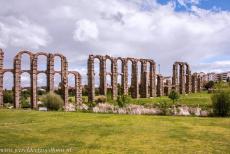
Archaeological Ensemble of Mérida: The Los Milagros Aqueduct was built in the first century AD. The Los Milagros Aqueduct was one of three aqueducts built at Augusta Emerita, present-day Mérida, the other two aqueducts were the San Lázaro Aqueduct and the Aqua Augusta. The Los Milagros Aqueduct has a maximum height of 25 metres. The arches were constructed of granite combined with brick. The Los Milagros Aqueduct crosses the River Albarregas.
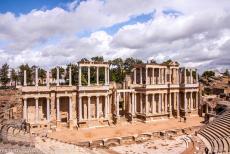
Archaeological Ensemble of Mérida: The Roman theatre of Mérida was built in 15 and 16 BC. The Roman theatre of Augusta Emerita is the most complete and best preserved Roman theatre in Europe. The theatre is situated close to the amphitheatre of Mérida. Since 1933, the Festival of Classical Theatre is held annually in the Roman theatre of Mérida. The Archaeological Ensemble of Mérida gained the status as a UNESCO World Heritage in 1993.
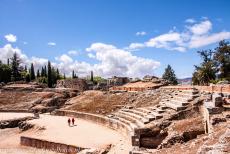
Archaeological Ensemble of Mérida: The Roman amphitheatre of Mérida was officially opened in 8 BC. The amphitheatre is situated close to the Roman theatre of Mérida. The city of Mérida was founded as Augusta Emerita in 25 BC, it was the capital city of the Roman province of Lusitania. Mérida has many impressive monuments from the Roman period, such as temples, a theatre, a stone bridge over the river Guadiana, aqueducts and the amphitheatre.
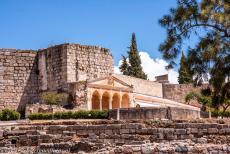
Archaeological Ensemble of Mérida: In the 8th century, the Arabs conquered Augusta Emerita. The Alcazaba was built as a military fortress in 835 AD, it was built on the remains of the Puerta del Puente, the Alcazaba was part of the city walls. The Alcazaba was the first Arab citadel on the Iberian Peninsula. Inside the fortress is a Roman reservoir for storing drinking water. After the Christian Reconquest of Spain, it was given to the Order of Santiago, they used it as a convent.
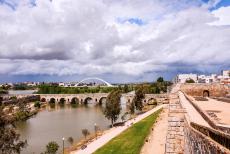
Archaeological Ensemble of Mérida: The Roman bridge over the Guadiana River, on the right hand side the Alcazaba. The Roman bridge is 792 metres long and 12 metres high above water level. Augusta Emerita, present-day Mérida, was one of the most important cities on the Iberian Peninsula, the bridge was a major crossing, the Roman roads crossing the Iberian Peninsula all met in Augusta Emerita. The bridge was the main entrance to Augusta Emerita.
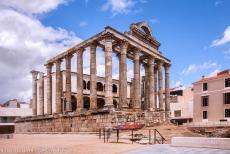
Archaeological Ensemble of Mérida: The Temple of Diana was erected by the Romans at the end of the first century BC. The temple is one of the oldest Roman buildings and the only example of Roman religious architecture in Mérida that was preserved in fairly good condition. The temple stands on a three metres high base and was originally situated in a sacred garden enclosed by a wall. The Archaeological Ensemble of Mérida is one of the largest archaeological sites in Spain.
